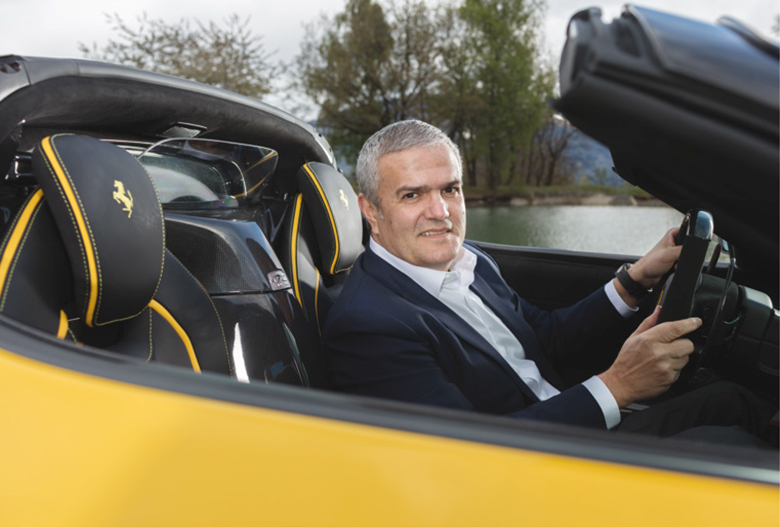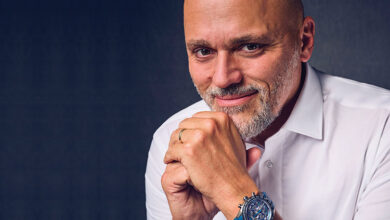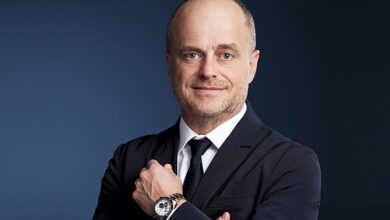
“Day & Night” magazine looks at the Techframe Ferrari 70 Years – the high point of a match, or rather, watch made in heaven – the result of a wonderful partnership between Hublot and Ferrari that has worked wonders in the world of haute horlogerie. We talk to the movers and shakers in both the maisons – Ricardo Guadalupe, CEO of Hublot; and Flavio Manzoni, Head of Design Ferrari – on how they collaborated in the creation of this amazing timepiece
The successful alliance between Hublot and Ferrari began in November 2011, when Jean-Claude Biver, CEO of Hublot, and Ferrari President Luca Cordero di Montezemolo took to the stage jointly at the Autodromo Internazionale del Mugello, the practice track for Scuderia Ferrari, to announce a long-term partnership between the brands. This included Hublot being the Official Timekeeper of Ferrari and the Official Watch of the Scuderia Ferrari, and incorporating inspiration and design cues from the most recent Ferrari models.
Horological results of this partnership include the Big Bang Ferrari Unico, the MP-05 “LaFerrari”, and now the Techframe Ferrari 70 Years. Tagged as “Designed by Ferrari, crafted by Hublot”, the Techframe Tourbillon Chronograph is a team effort that began in the Ferrari stronghold at Maranello and ended in Nyon at the Hublot manufacture. The Techframe was conceived with the intention of offering a “watch that is deeply rooted in Ferrari’s DNA– combining strength, performance, and agility – while being produced and perfected by the Hublot manufacture. A perfect fusion of the automotive and watchmaking worlds.”

We now bring you a behind-the-scenes look at what went into the creation of the Techframe in the words of Ricardo Guadalupe, CEO of Hublot.
Ferrari has had a lot of partnerships earlier, but the Hublot-Ferrari partnership is the most successful. Why is that?
It is true that Ferrari has had other watch brands as partners in the past, and they had not been very successful. So when we had the opportunity five years ago to get this partnership, we thought quite hard on how to make it work. We realised that the best way to make this successful was to work together and combine the themes of the two brands – Hublot and Ferrari.
The first step is to understand the values of the brands, and to activate this partnership in all the different worlds of Ferrari. So we were the first brand to really invest, for instance, in the Formula 1 with Scuderia Ferrari, and have the Hublot name on the cars – the Gran Tursimo cars – by activating our visibility in almost 100 per cent of dealerships of Ferrari in the world. We are also active in a majority of the clubs, and in every event organised by Ferrari. There are more than 200 events a year, as this year is the 70th anniversary of Ferrari the events are even bigger.
From the product point of view, we worked with a team from Ferrari under Manzoni to create a new product and not just put a logo on a watch. We created a completely new concept where every detail is inspired by the worlds of watchmaking and car racing – from Hublot and Ferrari – a very exclusive watch that would interest the owners of Ferrari cars. This 360°activation has been a key element in our partnership with Ferrari.
How did you manage to sell the idea that Hublot would make a great partner to Ferrari, when you first met them?
It was in 2006 and we were competing with Panerai at that time; the Hublot brand was in its infancy and we were just starting to be successful. Five years later, in 2011, we had a good relationship with Lapo Elkann, the grandson of the Agnelli family that owns the Ferrari and the Fiat Chrysler group. We owe our thanks to him, as he felt that Hublot would be a good match for Ferrari and so organised the meeting. Jean-Claude Biver, who is Chairman of the Board for Hublot in addition to his other responsibilities, went to Maranello and met with Luca Di Montezemolo, President of Ferrari, at that time. Elkann helped us convince Di Montezemolo that Hublot was the right partner, because of our Art of Fusion concept that respects tradition and quality, but also connects to the future with innovation and performance –values shared by Hublot and Ferrari.
Of all the partnerships that Hublot has had, the one with Ferrari exhibits perfect synergy and is so integral to both brands. Did you expect it to be as successful as it is today?
No; the fact that Ferrari chose Hublot to be a partner brings us to the level of Ferrari; that is a great honour and fantastic for Hublot. The Techframe is a watch that comes from the inspiration of Ferrari and opens new doors and a new era in watchmaking. It is not a Big Bang or a Classic Fusion; the Techframe is a super-interesting watch created by the Ferrari team that also carries the DNA of Hublot. We are working with Ferrari on developing new ideas where we will be creating watches that are totally different from the current industry level. There was a lot of research before we could create the architecture of the Techframe.
How difficult was it creating such a complicated case as the Techframe? And how has the feedback for the watch been?
As you know, the case was designed by Ferrari and when you get a design from car designers, there were some specifications that we had to adapt for a watch. Making a watch is very different from making a car even though there are many similarities. One of our advantages is that we have our own Manufacture; this is great not only in creating our own movements but also in developing new case designs. This has enabled us to acquire very sophisticated know-how in manufacturing cases of new materials that are technologically superior. The Techframe was designed and developed by Ferrari, while our Manufacture produced the watch.

When was it decided to create a special watch, such as the Techframe, to mark the 70th anniversary celebrations?
As partners, Hublot and Ferrari work together and we have a plan of development for the next four years. Two years ago, Ferrari told us that they had their 70th anniversary coming up and that we needed to think of a new watch. Today, Ferrari is working on cars that will be launched in the next two-three years, while Hublot is concurrently working on developing watches that are linked to the new cars being planned.
How hard was it to work collaboratively with Ferrari and Flavio Manzoni, who are new to watch designing?
We started with the engine, which in the case of a watch is the movement. Since it was for the 70th anniversary, we wanted something high end and so chose a chronograph tourbillon. Developing a new movement would have taken five years, so we decided to make some aesthetic changes to the movement and construct something around the movement. The Ferrari team worked in three different directions: one was the Techframe, which we finally chose; we may decide to pursue the other two designs in the future.
Which part of Techframe’s DNA comes from Ferrari cars?
The Techframe has been inspired by the chassis of Ferrari’s cars. Also Manzoni was inspired by the technical architecture of bridges and buildings; it was a kind of mixed inspiration from cars and other architectural elements.
Can you expound on the aesthetically beautiful movement of the Techframe?
As I explained earlier, because Hublot has its own manufacture, we could build on that. We had the Chronograph Unico, which is made 100 per cent in-house; we also had the haute horlogerie tourbillon chronograph – two complications together with a mono-pusher. Both are products of the technological advances of the Hublot manufacture. We chose the flying tourbillon, which is highly mechanical, and the chronograph with mono-pusher as we are targeting the sports world here. Ferrari was keen on fixing the movement with the crown at 4.30 or 5 o’clock, unlike the usual fixture of the crown at 3 o’clock as is normal. This moved the display of the tourbillon to 7 o’clock, which is quite interesting. This is also displayed in a counter similar to the one in a car, covered with a double hand.
What were the challenges you faced in creating the watch?
The design of this watch was so different that the first challenge was to come up with something ergonomic because if you look at the structure of the case, it had to go well on the wrist. The size had to fit; the balance between all the architectural elements had to be maintained to get an aesthetically appealing and wearable object. When you design a car, it is for 5 metres; in a watch, it is for 40 mm or 4cm, the challenge is to have the right proportion and detail on the watch.
With reference to Hublot’s Art of Fusion, is it possible that the Techframe might be launched in sapphire in the future?
In Hublot we believe that anything is possible, but we also want to maintain the Techframe as an iconic model commemorating Ferrari’s 70th anniversary. We have brought it out in three models and we might add a fourth, but it would essentially remain the same. We are hoping this watch becomes an iconic watch for Hublot and a collector’s piece. For any watch to be a collector’s item, it has to be a very limited edition.
What were the design elements that contributed to making the new Big Bang Ferrari, which carries so much of Ferrari’s DNA, differ substantially from the earlier one?
The Big Bang Ferrari was done in the early stages of our partnership and it had to be done in a short period of time. It was fully done by Hublot. For the second one, Manzoni said that he would like to collaborate on the development of the watch. So the design of this was done fully by the Ferrari team and they brought a new touch to the whole concept by bringing new aesthetics that contribute a lot of the Ferrari’s genes to the watch. I have to thank Manzoni and his team for bringing that additional touch to every detail of the watch – from the case to the crown, the pushers, dials, and so on. The result is truly fantastic.
Can we expect more releases from Hublot this year to celebrate Ferrari’s 70th anniversary?
No; Techframe is our main release for the year. We delivered the first ones in June-July, and the idea is to activate the 70-year celebrations with Ferrari in all the different countries. We have had a few joint events in Hong Kong, Singapore, and China; the last event is to be in Maranello with Ferrari in October. The agenda is mainly on joint activities focusing on the 70th anniversary and the launch of the Techframe.
The Spirit of Big Bang is really expanding year on year in comparison with the Big Bang Collection. Can we expect a Spirit of Big Bang Ferrari edition in the future?
I would say ‘No’ right now but who knows the future. The Spirit of Big Bang is really an exploration of a shaped watch with the inspiration of the Big Bang; that is why it is called the Spirit of Big Bang. It is an interesting watch to conquer new markets and to attract new consumers. The Chinese consumers, especially, are very keen on buying the Spirit of Big Bang; today the Spirit of Big Bang represents eight per cent of our sales, while we expected it to be only five per cent. Nearly 30 per cent of our sales to the Chinese is through the Spirit of Big Bang; it is helping us succeed very well in China.
Did you expect the Spirit of Big Bang to be such a major success?
No; we knew it had potential because it came in a smaller shape (42 mm) and we are now looking for an even smaller one to cater exclusively for the ladies next year.

Flavio Manzoni, Head of Design Ferrari
Flavio Manzoni was appointed Head of Design at Ferrari in January 2010; his earlier career includes stints as the Director of Creative Design at the Volkswagen Group (2007-2010) where he was involved in designing most of the recent Skoda, Bentley, Bugatti, and Volkswagen cars, as well as reimagining the aesthetic philosophy of these brands. From 2001 to 2006, he worked at Fiat Group as Head of Design for Lancia, Fiat, and LCV. He has also held design positions at Lancia and Seat. Manzoni holds a degree in architecture from the University of Florence.
And here we look into how Manzoni and his team designed a watch on the lines of a Ferrari project.

The Techframe is the first fully designed Ferrari product that is not a car. What were your challenges in the design process?
The Techframe is the latest watch fully conceived and developed in-house by Ferrari Design in collaboration with Hublot, to celebrate the 70th anniversary of Ferrari. Our partnership started in 2013 to realise the MP-05 LaFerrari, an original wristwatch with a display that resembles the engine of the first hybrid Ferrari supercar.
Since the beginning of the design phase, my team has been attracted by the Hublot technology and, over all, by the similitudes which the Ferrari cars and Hublot watches seem to have, particularly some steps of production as well as the high quality. The challenge was to bring the know-how, inspiration, and an approach from the world of car design to that of watchmaking.
They say creating a Ferrari car starts with an engine and then the rest of the car. Was this process also used for the watch?
The engine is always to be considered the heart of every Ferrari car. And all the design concepts for us start from there, but we can’t forget the importance of the chassis for a Ferrari supercar. That means considering all related features such as torsional rigidity, vehicle dynamics, and handling. It is precisely the latter that inspired the new Techframe, with the aim of maximising the value of the sophisticated HB6311movement and to enclose it into a reticular structure that recalls the chassis of Ferrari cars. We didn’t try to repeat the sensual and aerodynamic shapes of our car-bodies, because this is not an aerodynamic object, instead we worked a lot around the concept of lightness and its meanings.

How exactly did you hit upon the idea of the unique lattice structure that the watch boasts?
The chassis can be considered the key-point which synthesizes the entire design approach, from the first conceptualisation to the last virtual model check before the final prototype realisation. The use of a reticular structure has given a particular charm that derives from the beauty of certain mechanical elements to the wristwatch. Some Formula 1 components such as suspensions with their arms and their intrinsic beauty inspired our team.
Don’t the negative spaces (or cutouts) in the lattice structure of the case compromise the structural rigidity of the watch?
The voids of the structure do not compromise rigidity and strength because the materials used are titanium and carbon fibre. This was inspired not only by the chassis of our cars but also from the works ofengineer and architectPier Luigi Nervi, an Italian master known for his designs based on his study of the strength lines of structures. His lightened architectural designs follow the distribution of forces and are similar to shapes in nature. We had to balance highly resistant and light forms and use materials that gave the required rigidity.
The Techframe Ferrari represents a perfect fusion of the automotive and watchmaking worlds. How hard was it to combine such disparate industries?
It was possible to approach these two worlds by first believing in a culturally rich transaction and not a trivial transfer of ideas. Anything was possible starting from the principle of any Ferrari project: respecting the function and certain goals such as the use of highly performing materials. The resulting forms lighten and maximise the value and importance of this formal rigour that continuously guides us.
The watch is entrenched in Ferrari’s DNA – combining strength, performance, and agility. Was it difficult to translate that into a something as small as a timepiece?
When we received the go-ahead for the new Hublot Techframe, we perceived that this experience could be interesting and not so far from our practice and habits. It’s a more manageable object from the designer’s point of view, if compared with cars, in terms of numbers of pieces and components. As it is about 4.5 cm in diameter, during the modelling session, thanks to advanced virtual devices, we had displayed it as three to five meter wide. This allowed us to enter in every design detail and even to work in a microscopic scale. Techframe Ferrari Tourbillon Chronograph is like one of the super cars produced in Maranello. It’s deeply rooted in Ferrari’s DNA, combining strength, performance, and agility. Techframe is a perfect fusion of the automotive and watchmaking worlds.
The watch comes in 3 versions – king gold, carbon, and titanium. Which of these do you personally prefer?
The project was born with the aim of obtaining some harmony between the materials. The dial had to look a bit darker than the structure. Perhaps the grey-titanium is the most suitable material for this watch, which best exploits the ‘full and empty’ relationship to enhance the innovative concept.
Now that you have had your first experience at fully designing a watch, would you like to repeat the experience? And what would you do differently?
If we do get the opportunity, why not? Talking about the project, I would not change anything. We are pleased with the result. It has been a very linear and consistent development process that led us to reach this goal. There are, however, other ideas we have developed during the research phase that we will be able and glad to apply in the future.





